Decontamination of Spores on Model Stainless-Steel Surface by Using Foams Based on Alkyl Polyglucosides
Abstract
1. Introduction
2. Results and Discussion
2.1. Model Surfaces, Spores, and Surfactant Solutions Characterization
2.2. Effect of Surfactants on Spore Detachment under Static Conditions
2.3. Effect of Foams on the Detachment of Spores
2.4. Foam Characterizations before and after Flowing Inside the Duct
2.5. Foam Destruction and Recycling of Surfactant Solutions by Filtration
2.6. Life Cycle Assessment of the Foam Flow Process: Comparison between SDS and APGs
3. Materials and Methods
3.1. Materials
3.1.1. Preparation of Surfactant Solution
3.1.2. Preparation of Solid Model Surfaces
3.1.3. Preparation of Spore’s Suspension
3.1.4. Soiling of Surfaces with the Spores Suspension
3.2. Methods
3.2.1. Determination of the Critical Micelle Concentration by Surface Tension Measurements
3.2.2. Contact Angle Measurements of the Model Surface
3.2.3. Spores Detachment Analysis
3.2.4. Spores Detachment under Static Conditions
3.2.5. Production of Foams
3.2.6. Effect of Foams on the Detachment of Spores
3.2.7. Microscopic Observation of the Detachment of Spores
3.2.8. Foams Characterization
3.2.9. Surfactant Solution Cleaning by Filtration
3.2.10. Life Cycle Assessment
- The objective and scope definition;
- The inventory analysis;
- The environmental impact assessment;
- The interpretation of the results.
- The objective and scope definition
- The life cycle inventory
- The impact assessment
3.2.11. Statistical Analysis
4. Conclusions
Supplementary Materials
Author Contributions
Funding
Institutional Review Board Statement
Informed Consent Statement
Data Availability Statement
Acknowledgments
Conflicts of Interest
References
- Xue, L.; Liu, G.; Parfitt, J.; Liu, X.; Van Herpen, E.; Stenmarck, Å.; O’Connor, C.; Östergren, K.; Cheng, S. Missing Food, Missing Data? A Critical Review of Global Food Losses and Food Waste Data. Environ. Sci. Technol. 2017, 51, 6618–6633. [Google Scholar] [CrossRef] [PubMed]
- Faille, C.; Cunault, C.; Dubois, T.; Benezech, T. Hygienic Design of Food Processing Lines to Mitigate the Risk of Bacterial Food Contamination with Respect to Environmental Concerns. Innov. Food Sci. Emerg. Technol. 2018, 46, 65–73. [Google Scholar] [CrossRef]
- González-Rivas, F.; Ripolles-Avila, C.; Fontecha-Umaña, F.; Ríos-Castillo, A.G.; Rodríguez-Jerez, J.J. Biofilms in the Spotlight: Detection, Quantification, and Removal Methods: Biofilms DQR in the Food Industry…. Compr. Rev. Food Sci. Food Saf. 2018, 17, 1261–1276. [Google Scholar] [CrossRef] [PubMed]
- Deleplace, M.; Dallagi, H.; Dubois, T.; Richard, E.; Ipatova, A.; Bénézech, T.; Faille, C. Structure of Deposits Formed by Drying of Droplets Contaminated with Bacillus Spores Determines Their Resistance to Rinsing and Cleaning. J. Food Eng. 2022, 318, 110873. [Google Scholar] [CrossRef]
- Tsai, J.-H.; Huang, J.-Y.; Wilson, D.I. Life Cycle Assessment of Cleaning-in-Place Operations in Egg Yolk Powder Production. J. Clean. Prod. 2021, 278, 123936. [Google Scholar] [CrossRef]
- Wirtanen, G.; Salo, S. Disinfection in Food Processing–Efficacy Testing of Disinfectants. Rev. Environ. Sci. Biotechnol. 2003, 2, 293–306. [Google Scholar] [CrossRef]
- Lyndgaard, C.B.; Rasmussen, M.A.; Engelsen, S.B.; Thaysen, D.; van den Berg, F. Moving from Recipe-Driven to Measurement-Based Cleaning Procedures: Monitoring the Cleaning-In-Place Process of Whey Filtration Units by Ultraviolet Spectroscopy and Chemometrics. J. Food Eng. 2014, 126, 82–88. [Google Scholar] [CrossRef]
- Gossard, A.; Lilin, A.; Faure, S. Gels, coatings and foams for radioactive surface decontamination: State of the art and challenges for the nuclear industry. Prog. Nucl. Energy 2022, 149, 104255. [Google Scholar] [CrossRef]
- Dallagi, H.; Faille, C.; Bouvier, L.; Deleplace, M.; Dubois, T.; Aloui, F.; Benezech, T. Wet Foam Flow: A Suitable Method for Improving Surface Hygiene in the Food Industry. J. Food Eng. 2022, 322, 110976. [Google Scholar] [CrossRef]
- Al Saabi, A.; Dallagi, H.; Aloui, F.; Faille, C.; Rauwel, G.; Wauquier, L.; Bouvier, L.; Bénézech, T. Removal of Bacillus Spores from Stainless Steel Pipes by Flow Foam: Effect of the Foam Quality and Velocity. J. Food Eng. 2021, 289, 110273. [Google Scholar] [CrossRef]
- Dallagi, H.; Faille, C.; Gruescu, C.; Aloui, F.; Benezech, T. Foam Flow Cleaning, an Effective and Environmentally Friendly Method for Controlling the Hygiene of Closed Surfaces Contaminated with Biofilms. Food Bioprod. Process. 2022, 136, 236–248. [Google Scholar] [CrossRef]
- Denkov, N.D.; Subramanian, V.; Gurovich, D.; Lips, A. Wall Slip and Viscous Dissipation in Sheared Foams: Effect of Surface Mobility. Colloids Surf. Physicochem. Eng. Asp. 2005, 263, 129–145. [Google Scholar] [CrossRef]
- Denkov, N.D.; Tcholakova, S.; Golemanov, K.; Subramanian, V.; Lips, A. Foam–Wall Friction: Effect of Air Volume Fraction for Tangentially Immobile Bubble Surface. Colloids Surf. Physicochem. Eng. Asp. 2006, 282–283, 329–347. [Google Scholar] [CrossRef]
- Denkov, N.D.; Tcholakova, S.; Golemanov, K.; Ananthpadmanabhan, K.P.; Lips, A. The Role of Surfactant Type and Bubble Surface Mobility in Foam Rheology. Soft Matter 2009, 5, 3389. [Google Scholar] [CrossRef]
- Drenckhan, W.; Saint-Jalmes, A. The Science of Foaming. Adv. Colloid Interface Sci. 2015, 222, 228–259. [Google Scholar] [CrossRef]
- Le Toquin, E.; Faure, S.; Orange, N.; Gas, F. New Biocide Foam Containing Hydrogen Peroxide for the Decontamination of Vertical Surface Contaminated With Bacillus Thuringiensis Spores. Front. Microbiol. 2018, 9, 2295. [Google Scholar] [CrossRef]
- Ranieri, D.; Preisig, N.; Stubenrauch, C. On the Influence of Intersurfactant H-Bonds on Foam Stability: A Study with Technical Grade Surfactants. Tenside Surfactants Deterg. 2018, 55, 6–16. [Google Scholar] [CrossRef]
- Nickel, D.; Von Rybinski, W.; Kutschmann, E.; Stubenrauch, C.; Findenegg, G.H. The Importance of the Emulsifying and Dispersing Capacity of Alkyl Polyglycosides for Applications in Detergent and Cleaning Agents. Lipid/Fett 1996, 98, 363–369. [Google Scholar] [CrossRef]
- Dubois, T.; Krzewinski, F.; Yamakawa, N.; Lemy, C.; Hamiot, A.; Brunet, L.; Lacoste, A.-S.; Knirel, Y.; Guerardel, Y.; Faille, C. The Sps Genes Encode an Original Legionaminic Acid Pathway Required for Crust Assembly in Bacillus Subtilis. mBio 2020, 11, e01153-20. [Google Scholar] [CrossRef]
- Fang, J.P.; Joos, P. The Dynamic Surface Tension of SDS—Dodecanol Mixtures. Colloids Surf. 1992, 65, 113–120. [Google Scholar] [CrossRef]
- Bhuyan, A.K. On the Mechanism of SDS-Induced Protein Denaturation. Biopolymers 2010, 93, 186–199. [Google Scholar] [CrossRef] [PubMed]
- Fameau, A.-L.; Lam, S.; Velev, O.D. Multi-Stimuli Responsive Foams Combining Particles and Self-Assembling Fatty Acids. Chem. Sci. 2013, 4, 3874. [Google Scholar] [CrossRef]
- Daufin, G.; Escudier, J.-P.; Carrère, H.; Bérot, S.; Fillaudeau, L.; Decloux, M. Recent and Emerging Applications of Membrane Processes in the Food and Dairy Industry. Food Bioprod. Process. 2001, 79, 89–102. [Google Scholar] [CrossRef]
- Arnould, A.; Cousin, F.; Salonen, A.; Saint-Jalmes, A.; Perez, A.; Fameau, A.-L. Controlling Foam Stability with the Ratio of Myristic Acid to Choline Hydroxide. Langmuir 2018, 34, 11076–11085. [Google Scholar] [CrossRef] [PubMed]
- Van Lieshout, K.G.; Bayley, C.; Akinlabi, S.O.; von Rabenau, L.; Dornfeld, D. Leveraging Life Cycle Assessment to Evaluate Environmental Impacts of Green Cleaning Products. Procedia CIRP 2015, 29, 372–377. [Google Scholar] [CrossRef]
- Faille, C.; Lemy, C.; Allion-Maurer, A.; Zoueshtiagh, F. Evaluation of the Hydrophobic Properties of Latex Microspheres and Bacillus Spores. Influence of the Particle Size on the Data Obtained by the MATH Method (Microbial Adhesion to Hydrocarbons). Colloids Surf. B Biointerfaces 2019, 182, 110398. [Google Scholar] [CrossRef]
- ISO 14040:2006—Environmental Management—Life Cycle Assessment—Principle and Framework. Available online: https://www.iso.org/standard/37456.html (accessed on 24 November 2022).
- ISO 14044:2006—Environmental Management—Life Cycle Assessment—Requirements and Guidelines. Available online: https://www.iso.org/standard/38498.html (accessed on 24 November 2022).
- Brière, R.; Loubet, P.; Glogic, E.; Estrine, B.; Marinkovic, S.; Jérôme, F.; Sonnemann, G. Life Cycle Assessment of the Production of Surface-Active Alkyl Polyglycosides from Acid-Assisted Ball-Milled Wheat Straw Compared to the Conventional Production Based on Corn-Starch. Green Chem. 2018, 20, 2135–2141. [Google Scholar] [CrossRef]
- Gésan-Guiziou, G.; Sobańtka, A.P.; Omont, S.; Froelich, D.; Rabiller-Baudry, M.; Thueux, F.; Beudon, D.; Tregret, L.; Buson, C.; Auffret, D. Life Cycle Assessment of a Milk Protein Fractionation Process: Contribution of the Production and the Cleaning Stages at Unit Process Level. Sep. Purif. Technol. 2019, 224, 591–610. [Google Scholar] [CrossRef]
- Goedkoop, M.; Heijungs, R.; Huijbregts, M.; De Schryver, A.; Struijs, J.; Van Zelm, R. ReCiPe 2008. In Life Cycle Impact Assess. Method Which Comprises Harmon. Categ. Indic. Midpoint Endpoint Level; Ministerie van Volkshuisvesting: Amsterdam, The Netherlands, 2009; Volume 1, pp. 1–126. [Google Scholar]
- Dame, C.; Fritz, C.; Pitois, O.; Faure, S. Relations between Physicochemical Properties and Instability of Decontamination Foams. Colloids Surf. Physicochem. Eng. Asp. 2005, 263, 210–218. [Google Scholar] [CrossRef]
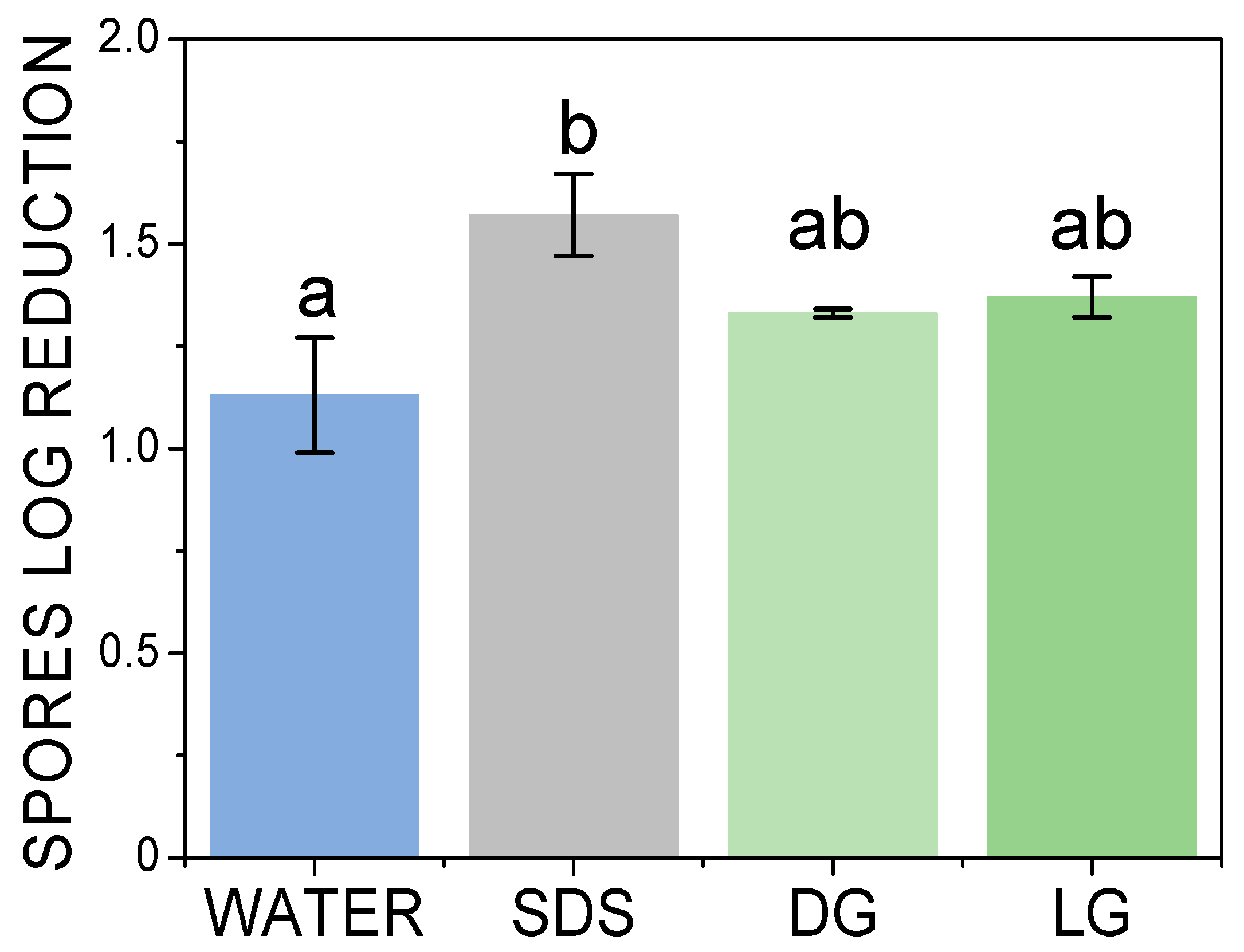
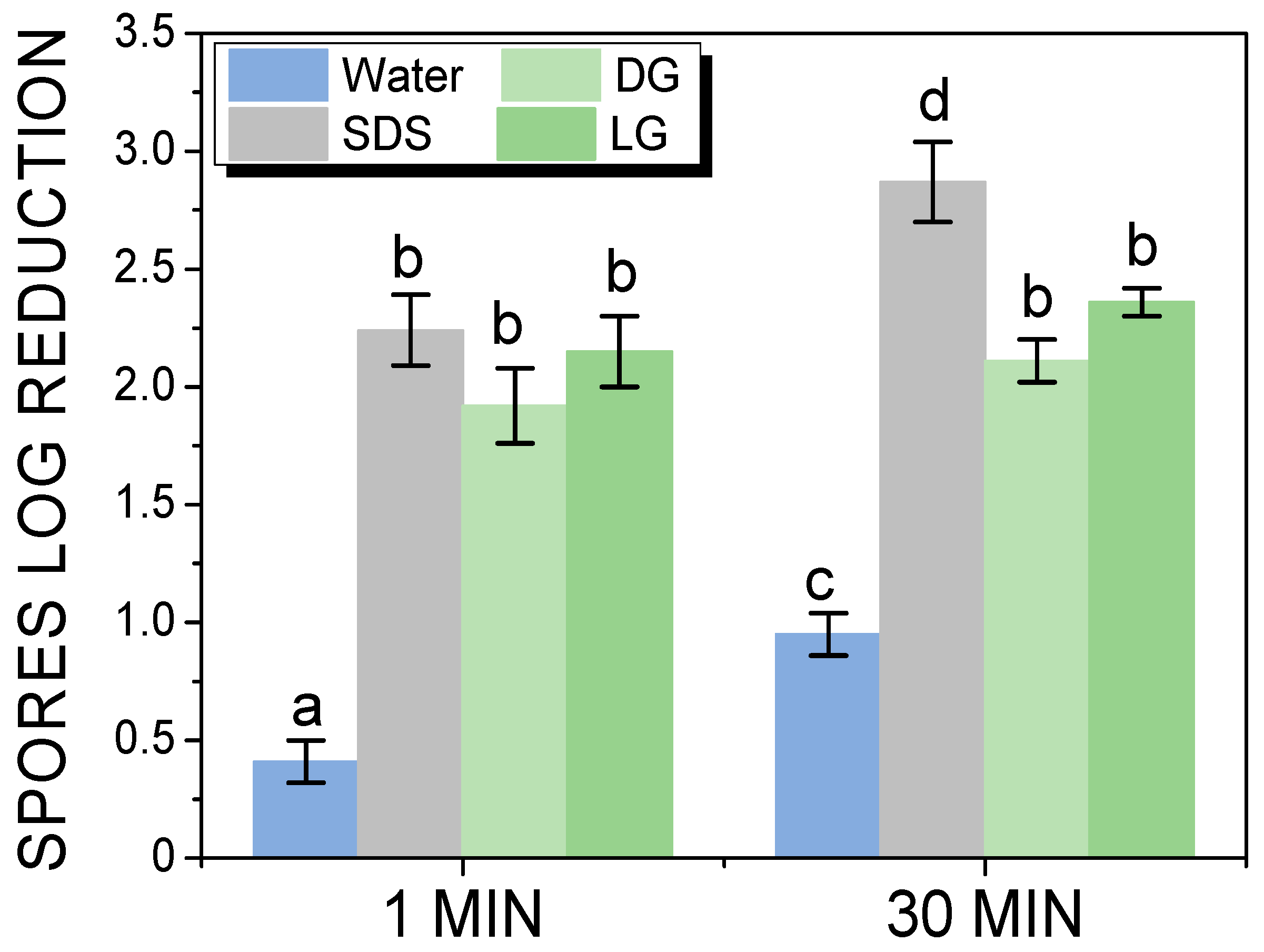



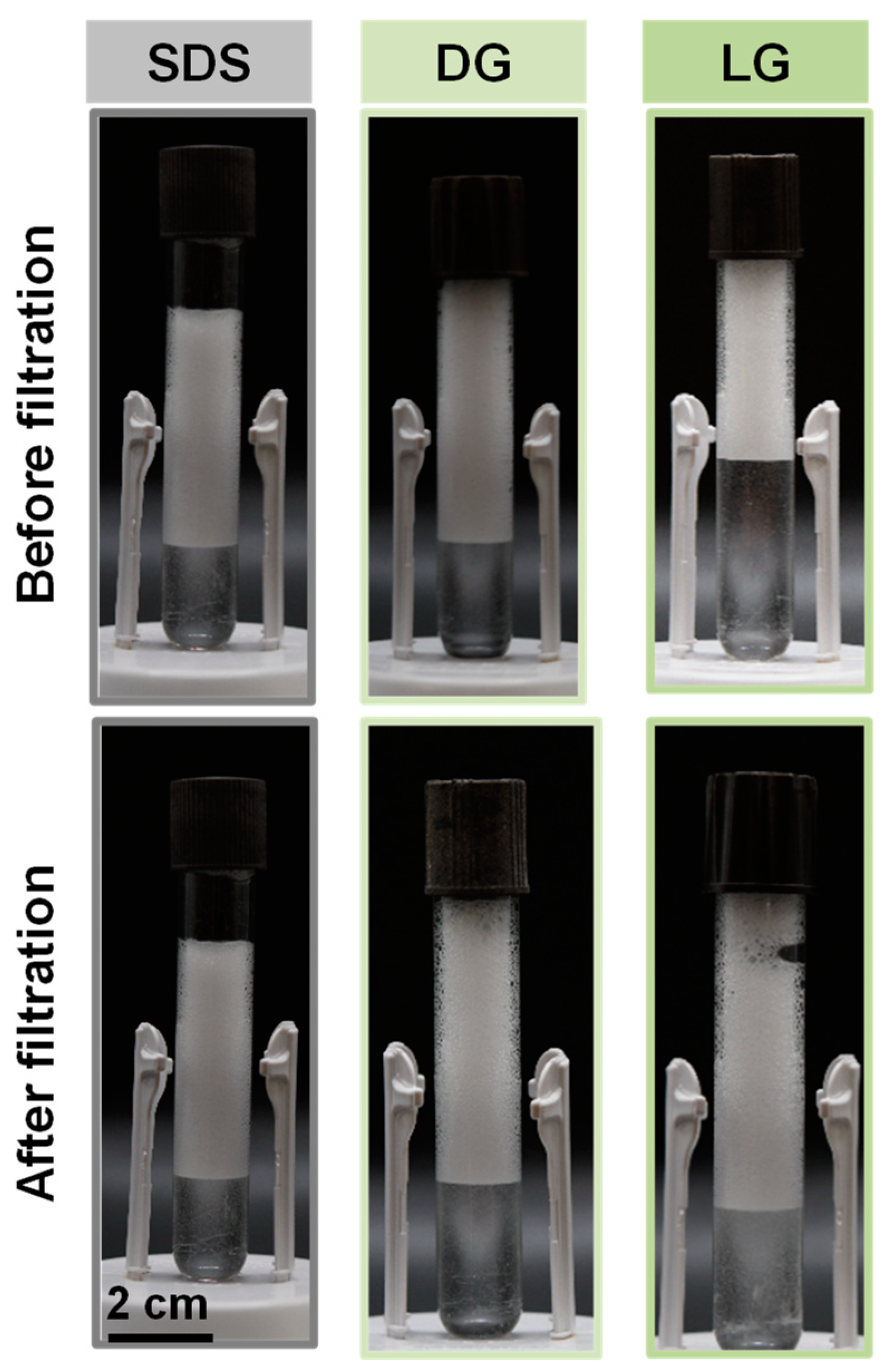
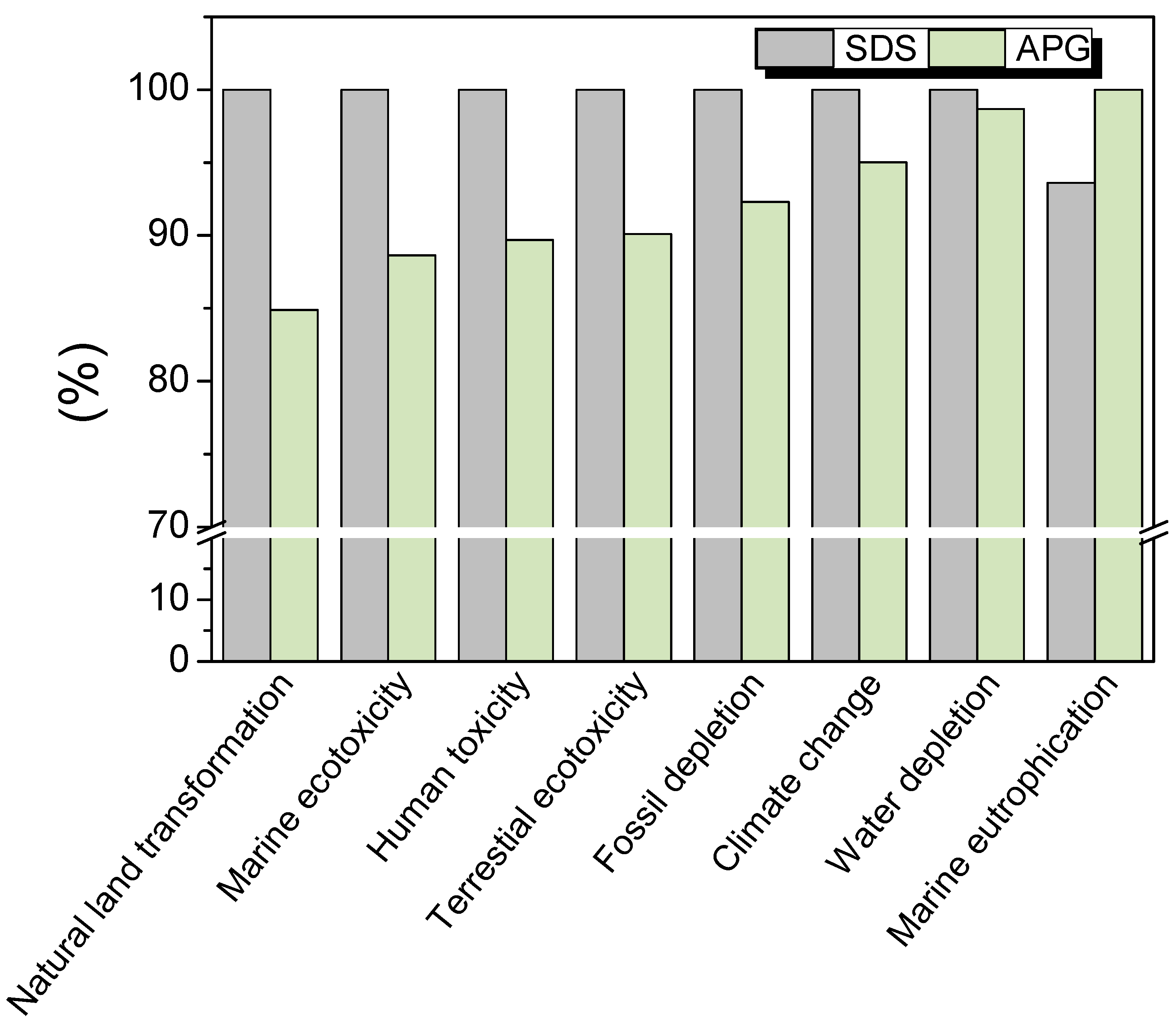

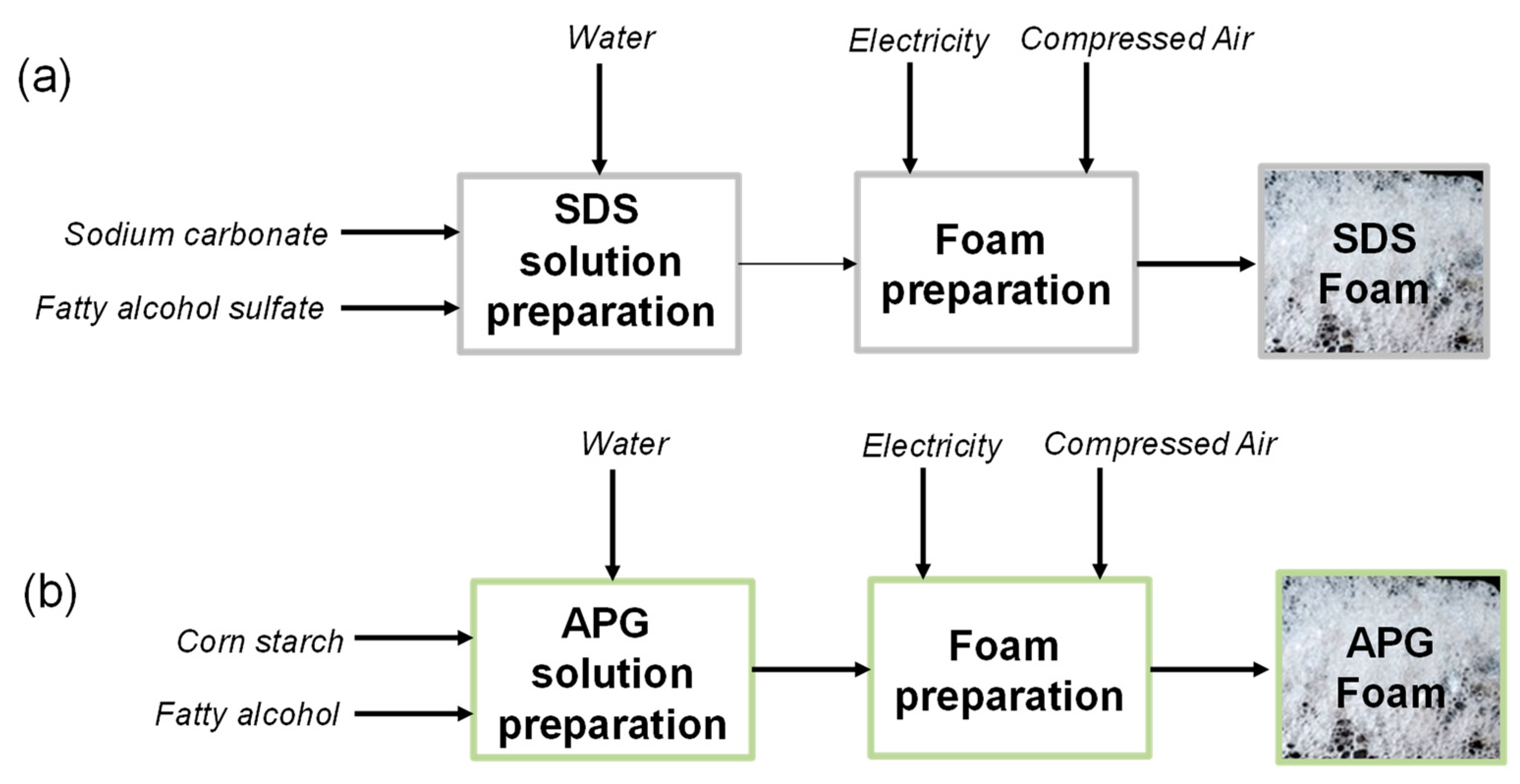
Disclaimer/Publisher’s Note: The statements, opinions and data contained in all publications are solely those of the individual author(s) and contributor(s) and not of MDPI and/or the editor(s). MDPI and/or the editor(s) disclaim responsibility for any injury to people or property resulting from any ideas, methods, instructions or products referred to in the content. |
© 2023 by the authors. Licensee MDPI, Basel, Switzerland. This article is an open access article distributed under the terms and conditions of the Creative Commons Attribution (CC BY) license (https://creativecommons.org/licenses/by/4.0/).
Share and Cite
Dari, C.; Dallagi, H.; Faille, C.; Dubois, T.; Lemy, C.; Deleplace, M.; Abdallah, M.; Gruescu, C.; Beaucé, J.; Benezech, T.; et al. Decontamination of Spores on Model Stainless-Steel Surface by Using Foams Based on Alkyl Polyglucosides. Molecules 2023, 28, 936. https://doi.org/10.3390/molecules28030936
Dari C, Dallagi H, Faille C, Dubois T, Lemy C, Deleplace M, Abdallah M, Gruescu C, Beaucé J, Benezech T, et al. Decontamination of Spores on Model Stainless-Steel Surface by Using Foams Based on Alkyl Polyglucosides. Molecules. 2023; 28(3):936. https://doi.org/10.3390/molecules28030936
Chicago/Turabian StyleDari, Carolina, Heni Dallagi, Christine Faille, Thomas Dubois, Christelle Lemy, Maureen Deleplace, Marwan Abdallah, Cosmin Gruescu, Julie Beaucé, Thierry Benezech, and et al. 2023. "Decontamination of Spores on Model Stainless-Steel Surface by Using Foams Based on Alkyl Polyglucosides" Molecules 28, no. 3: 936. https://doi.org/10.3390/molecules28030936
APA StyleDari, C., Dallagi, H., Faille, C., Dubois, T., Lemy, C., Deleplace, M., Abdallah, M., Gruescu, C., Beaucé, J., Benezech, T., & Fameau, A.-L. (2023). Decontamination of Spores on Model Stainless-Steel Surface by Using Foams Based on Alkyl Polyglucosides. Molecules, 28(3), 936. https://doi.org/10.3390/molecules28030936






